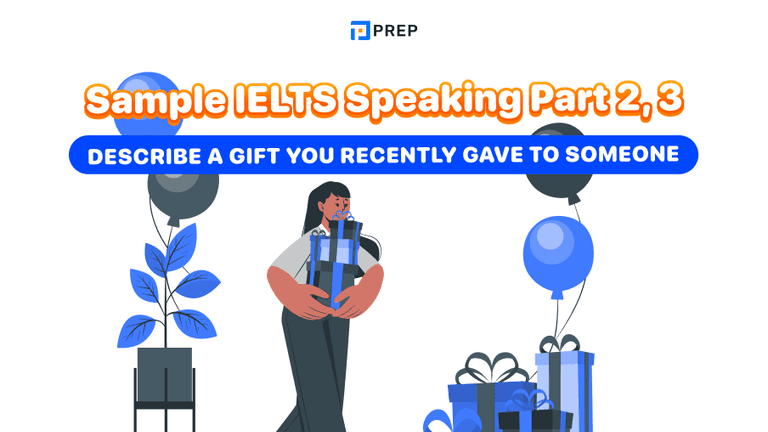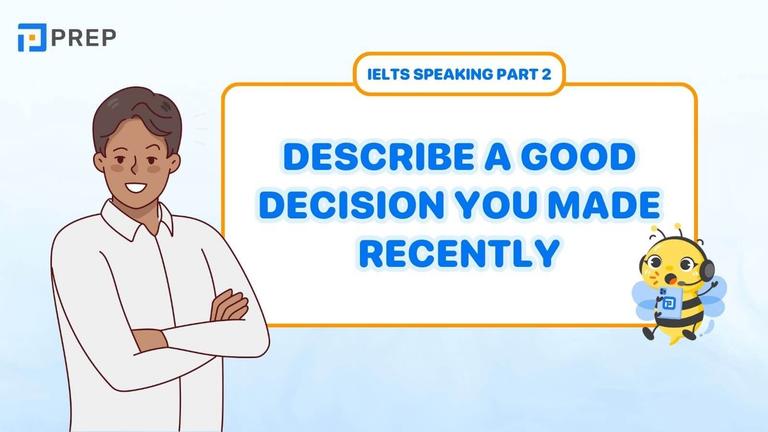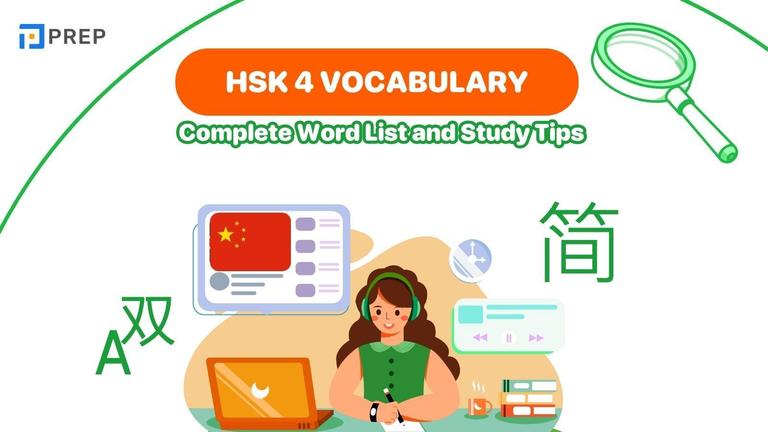Master extremely effective TOEIC tips to help you conquer high scores!
With 7 main test sections, each part of the TOEIC test requires distinct skills and strategies. In this article, PREP will share TOEIC tips to help you "score the full" 990 points, giving you confidence to pass this exam and achieve excellent results!
I. TOEIC tips for Listening section
The TOEIC listening test structure has 4 parts, including:
-
Part 1: Picture Description
-
Part 2: Question-Response
-
Part 3: Conversations
-
Part 4: Talks
With these different structures, you'll need different TOEIC test strategies for each part. Come and explore high-scoring TOEIC tips for the Listening section with PREP!
1. Part 1
Part 1 requires you to look at a picture and choose the correct answer from 4 options that aren't displayed. TOEIC tips you can apply include:
-
Preview the picture before listening: Before Part 1 content plays, start reading the questions and take a moment to observe the picture. Try to identify vocabulary and verbs that might appear in the question. Think about questions like: who, what, when, where.
-
Pay attention to actions and positions: The picture may describe people performing actions, often using present continuous verbs (e.g., "He is repairing the machine") or passive voice (e.g., "The machine is being repaired"). To answer correctly, you need to note both the action and the position of people or objects in the image.
-
Pay attention to prepositions: Questions may relate to the position of people or objects in the picture, using prepositions of place (beside, in front of, next to,...) or prepositions of movement (towards, through, across,...). Be careful because the action might be correct but the position of people or objects might be wrong.
-
Pay attention to small details: You need to carefully observe every detail in the picture, even seemingly insignificant points. Although not common, sometimes the test will ask questions about minor details rather than focusing on prominent elements of the picture. This is a strategy used by test makers to check candidates' detailed observation ability and prevent candidates from focusing only on main details while overlooking secondary elements in the image.
-
Don't rely on assumptions: To choose the correct answer, you need to rely on what's actually in the picture, not your assumptions. Make sure the correct answer is based on what you see in the image, not just what you think.
-
Check again after finishing: If practicing at home, after completing Part 1, you should pause to check your answers. Note any new vocabulary that appears in the answers and think about why some answers are wrong. These TOEIC tips will help you improve your ability to identify images and understand questions in future tests.
Let's look at the following example for better understanding:
From the image above, you can try to make the following predictions about the picture:
-
Activity: A girl is smiling and talking on the phone. Words you might associate include: smile, phone call, hold, laptop,...
-
General context: The scene appears to take place in an office, as the girl is wearing business attire and there's a laptop, pen holder, notebook, etc. on the desk. A possible answer that might appear in the listening section is "There is a laptop on the desk".
-
Relationship between objects: The pen holder is in front of the laptop or the notebook is behind the desk phone,...
-
Less noticeable points: File folders on the shelf, business cards on the desk,....
2. Part 2
In part 2, you'll hear a question/statement and choose an answer from 3 options that aren't displayed. 8 TOEIC tips to help improve your score include
-
Focus on the question list: Whether you choose online or paper testing, pay attention to the position of the question being mentioned in the audio. Since neither questions nor answers are displayed in advance, it's easy to lose track of question positions. This can easily lead to selecting the correct answer for the wrong question, causing you to lose points unnecessarily.
-
Keep the question in mind: When listening to the three answers, think about and choose the answer that makes logical sense with the question. Questions starting with words like "who, what, when, where, why" usually require a logical answer. For instance, questions beginning with "when" require you to pay attention to answers related to time rather than location or subject.
-
Answers are sometimes indirect: Sometimes the best answer isn't a direct response to the question. For example, the question "How many applicants applied for the position?" might have the answer "I'm disappointed because we haven't received as many CVs as we expected." This reflects how English is used in reality, where answers don't always relate to the grammar of the question.
-
Pay attention to questions with "question tags": You'll encounter question tag formats in Part 2. For example, for the question "You reserved the conference room, didn't you?" the answer could be "Yes, I did." or "No, I didn't." Pay attention and choose the correct answer for this type of question.
-
Be careful with questions about words with multiple meanings: One of the biggest challenges when taking the TOEIC test, especially in listening sections, is dealing with words that sound the same but have different meanings. This is one of the "traps" that test-takers easily fall into. For example, the word "bark" can mean tree bark or a dog's bark, but if the listening passage relates to animals, this word likely means a dog's bark.
-
Pay attention to homonyms with different meanings: For difficult questions, you'll also encounter words that sound identical or similar but have completely different meanings. For example: "read" and "reed" sound the same but have different uses. Listen to whether the word is used as a verb or noun to help distinguish them.
-
Answers on the same topic but unrelated to each other: Don't rush to mark an answer as soon as you hear a keyword from the question. Sometimes, the answer may only mention a topic similar to the question but provide incorrect or incomplete information. Pay attention to specific details in the answer, as sometimes small differences between options can be the deciding factor.
-
"I don't know" answers are often correct: If you miss information in the listening but catch the phrase "I don't know," don't hesitate to choose it! From experience, this answer is correct 99% of the time.
Let's look at the following example to better understand TOEIC tips!
Statement: "I've been working at the company for 5 years." Answer choices:
-
A. That's great! What position do you hold there?
-
B. How long have you been studying?
-
C. Oh, I am an accountant in a food company.
Explanation:
-
Answer A is correct because this question further explores details about the job position, directly related to the initial statement about working time.
-
Answer B is incorrect because although it's on the same topic of time, it's not related to working time at the company.
-
Answer C is incorrect because it's completely unrelated to the statement.
3. Part 3 and Part 4
Although the requirements for Part 3 and Part 4 may differ, you can apply general TOEIC test strategies for both parts. TOEIC tips for part 3 and part 4 that you should know include:
-
Identify important questions: Before starting the listening, try to memorize key questions, especially those related to characters, locations, topics, and the purpose of the conversation. If you don't have enough time to read the questions before the conversation begins, focus on listening and identifying these elements:
-
Who is participating in the conversation
-
What are their professions?
-
What is the relationship between them?
-
Where are they?
-
What are they discussing?
-
Why are they discussing this issue?
-
-
Listen carefully to identify elements in the questions: While listening, you need to pay attention to every detail in the conversation. Clearly identifying who is participating and their occupations will help you better understand the context of the conversation. Identifying the relationship between participants also helps you avoid confusion in the answers.
-
Focus on the topic and purpose of the conversation: Listen carefully to understand the topic they're discussing and why they're discussing it. This information is crucial for answering questions about the main content and reason for the conversation.
-
Pay attention to context and keywords: Questions in TOEIC Part 3 can be better answered if you pay attention to keywords in the conversation, such as "meeting", "conference", "project", "deadline",... These words will help you immediately identify the correct answer when the question appears.
-
Practice listening skills with various situations: To become familiar with this type of question, practice listening to conversations in work situations or daily life. This helps you easily answer questions during the test.
Now you have the TOEIC tips for TOEIC Part 4 and Part 3 to achieve high scores!
II. TOEIC Tips for Reading Section
Thank you for sharing these tips for the TOEIC Reading section, specifically focusing on Part 5. Let me expand on these strategies and provide some additional insights to help you maximize your score.
5. Part 5
For Part 5, you will be asked to fill in missing words/phrases in sentences. Here are essential TOEIC tips for Part 5 to help you achieve a high score:
-
Examine the answer choices first: Before reading the question, look at the four answer choices and identify their similarities, such as whether they are all nouns, prepositions, or verbs. Then, identify the differences between the options (for example: same type of word but different meanings, or words from different word families). This helps you recognize what type of word is appropriate for the blank space.
-
Read the question and look for clues: After identifying the similarities and differences of the answer choices, continue reading the question to find clues that help you select the correct answer. This will help you know what type of word needs to be filled in the blank.
-
Pay attention to grammar and vocabulary: Questions in this section typically require you to choose elements such as: verb tenses, pronouns, adjective forms (-ed, -ing,...), conjunctions (and, but, because of,...), or similar vocabulary. Read the question carefully to select the appropriate answer!
-
Allocate time wisely: Compared to Part 7, Part 5 is considered much easier. Therefore, you should only spend about 30 seconds on each question. If you exceed this time, move on to another question and return when you have completed the entire test. If you spend too much time on Part 5, you definitely won't be able to finish Part 7, which has many passages and 54 reading comprehension questions.
-
Build a solid vocabulary: A rich vocabulary is also one of the factors that helps you achieve a high TOEIC score. Therefore, don't forget to spend time learning vocabulary to upgrade your word bank!
6. Part 6
Part 6 will require you to complete a passage. The TOEIC tips for part 6 you need to note are:
-
Start with the first question: Don't get caught up in reading the entire passage. Begin right away with the first question and analyze the four answer choices to find similarities or differences between them. Then, read the sentence in the passage containing the blank. This helps you easily focus on the section that needs to be filled without being distracted by unnecessary information.
-
Focus on grammar and vocabulary: Part 6 mainly tests grammar and vocabulary, not reading comprehension. Therefore, don't try to comprehend the entire passage, instead pay attention to the grammar and vocabulary of the question to select the appropriate answer.
-
Skim to find clues: In some cases, the question may not provide enough information within the sentence. At this point, "skim" (quickly scan) the surrounding sentences to find clues. However, you must do this quickly to avoid wasting time.
-
Answer quickly and don't linger: Answer questions quickly and don't get stuck on one question for too long. If you encounter a difficult question, skip it and come back later. This helps you save time for subsequent questions.
7. Part 7
For Part 7, this is the final and considered the most difficult section. This part will require you to read information texts and answer questions. Many test-takers lose a lot of points in this section because they don't know the TOEIC tips for Part 7. Apply these tips to achieve a perfect score in this section:
-
Identify the type of document: First, quickly recognize the types of documents presented in Part 7 such as emails, price lists, graphs, bulletin boards, or even online conversations. This will help you identify the type of information you need to look for.
-
Read the questions before reading the passage: Before diving into reading the passage, read the questions first. This helps you clearly identify the content you need to find in the text and saves time.
-
Use "skimming" and "scanning" skills: "Skimming" is browsing through text to find the main ideas, such as email subjects or the first paragraphs of a complaint letter. "Scanning" is searching for specific information, such as dates, names, order numbers, etc. For both techniques, you need to look for keywords in the questions to determine which parts of the text need careful reading.
-
Pay attention to the structure of the text: With each type of text, important information will be in different sections. For example, in a complaint letter, important information is usually in the first paragraph (such as order date and order number), while the main content is usually in the next section. Similarly, in an article, read the title and subheadings to find the main section to focus on.
-
Solve easy questions first: Some questions asking for detailed information can be answered quickly. Start with these questions, find the relevant part of the text, and answer immediately.
-
Pay attention to questions about general meaning or author's purpose: These questions require you to understand the content deeply and may take more time. Therefore, don't rush but take time to read the relevant text carefully and think thoroughly.
-
Save difficult questions: If you encounter difficult questions, don't worry too much and skip them. At the end of the test, you can return to unanswered questions and choose answers quickly.
-
Practice extensively: The more you practice with TOEIC Part 7 tests, the more familiar you become with quickly identifying the type of information needed and improving your speed. Not only for Part 7, any test section requires diligent practice to achieve a high score.
-
Time management for the TOEIC test:
-
The tip for this part is to divide into two distinct time periods for the two parts of Part 7 and reverse the order of working as follows:
-
First 20 minutes: Read from question 200 down to question 180 (Double passages)
-
Next 30 minutes: Read from question 147 up to question 179 (Single passages)
-
-
When allocating time in reverse like this, you will do the most difficult part when you are still alert and not too tired, still having energy to complete all multiple passages. Then, when we are nearly out of "endurance," it's also time to approach the easier part, which is the single passage.
-
III. TOEIC Tips for Speaking and Writing Section
1. TOEIC Speaking Strategies
To excel in the TOEIC Speaking test, here are detailed strategies for every part of the exam:
|
Part |
TOEIC Tips |
|
Read a Text Aloud (Questions 1-2) |
Scoring criteria for this part include pronunciation, intonation, pauses, and stress. Key tips to master this part are:
|
|
Part 2: Describe a Picture (Questions 3-4) |
"Observing and analyzing pictures: You should pay attention to each detail, characteristic, and the relationship between objects appearing in the image. To avoid missing important information, you can quickly jot down the main points of the picture on scratch paper, helping organize ideas systematically before presenting.
|
|
Responding to On-screen Questions (Part 3: Questions 5-7) |
|
|
Answering Questions Based on Provided Information (Part 4: Questions 8-10) |
|
|
Expressing an Opinion (Question 8) |
|
In addition, some important TOEIC tips for speaking section that can be applied to all questions in this test are:
-
Speak as clearly as possible: The most important thing in the TOEIC speaking section is to speak as clearly as possible, regardless of your accent. Additionally, you will answer questions through a microphone and other test-takers will do the same, so the testing room will be very noisy. Therefore, you need to speak loudly to avoid being drowned out by other test-takers.
-
Practice speaking in noisy environments: As mentioned, the Speaking test room will be very noisy because all test-takers are trying to speak loudly and clearly. Those who aren't accustomed to this may easily get distracted and find it difficult to concentrate. Therefore, practice in noisy environments or find videos containing background noise. Your task is to focus on speaking while ignoring all surrounding factors. This approach can make a significant difference in your performance and speaking score.
-
Use correct grammar: The TOEIC Speaking test is more formal, so one more TOEIC tips is to avoid non-standard expressions like 'ain't,' even if you frequently hear these words in movies or daily life.
-
Appropriate speaking pace: This is the key to ensuring your message is effectively conveyed. You should speak at a moderate pace as this is the only way to ensure the listener can clearly understand your point. There's no value in giving an excellent answer that no one can understand because you speak too quickly.
2. Strategies for the TOEIC Writing Test
Compared to the TOEIC Speaking section, the TOEIC Writing test is considered easier, offering clear structures and strategies for you to follow. Achieving a high score—even full marks (200 points)—is entirely possible if you prepare well. Check out the article "Everything You Need to Know about the TOEIC Writing Test" to understand the complete details, including the structure, scoring criteria, evaluation standards, study materials, sample questions, and test-taking strategies.
PREP has provided comprehensive information above. However, aside from mastering test strategies, TOEIC tips, you also need to build a solid foundation of grammar, vocabulary, and keep your confidence high. Best of luck in achieving your desired TOEIC score!
PREP – the smart learning & exam preparation platform powered by exclusive AI technology, helps you study English effectively online.

Hi I'm Chloe, and I am currently serving as an Product Content Administrator at Prep Education. With over five years of experience in independent online IELTS study and exam preparation, I am confident in my ability to support learners in achieving their highest possible scores.
Comment
Premium content
View allPersonalized roadmap
Most read












